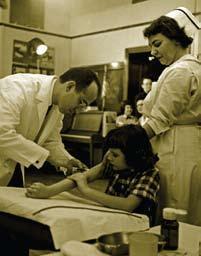by
Sean Ruck, Contributing Editor | April 15, 2009

Polio Vaccine
Is Made Public
This report originally appeared in the April 2009 issue of DOTmed Business News
Polio Vaccine is Made Public
With the possible exception of AIDS, there hasn't been a disease in American history causing more public concern than the polio epidemics that would spring-up periodically across the country barely more than five decades ago.



Ad Statistics
Times Displayed: 174538
Times Visited: 3184 For those who need to move fast and expand clinical capabilities -- and would love new equipment -- the uCT 550 Advance offers a new fully configured 80-slice CT in up to 2 weeks with routine maintenance and parts and Software Upgrades for Life™ included.
Polio has plagued humans for thousands of years. In fact, there are stone engravings in Egypt referencing the paralyzing affects of the disease dating back three millennia. Ironically, the disease became a larger problem over the centuries as sanitation improved. With the improvement, there was less exposure to the Polio virus, which translated to less people building immunity. That meant when someone did contract it, it had a greater chance of being more virulent and stood a better chance of becoming an epidemic. That was the case in America in the early 1900s, with repeated large outbreaks. One outbreak had reports of more than 9,000 cases in New York City alone. During that stretch, Franklin Delano Roosevelt would contract the disease, a decade before being elected President. Shortly after World War II, the United States averaged more than 20,000 cases a year from 1945 to 1949 with about 1% of the cases leading to paralysis. The public by this time was in a panic. The National Foundation for Infantile Paralysis, now known as the March of Dimes, undertook a strong fundraising effort to provide money for researching a vaccine. The money helped fund the research of Dr. Jonas Salk.
Salk, building his work upon that of John Enders at Harvard University, created a vaccine using dead viruses, which was able to immunize against the living virus while only creating a mild infection. He reported his findings to the American Medical Association and nationwide testing commenced, sponsored by the March of Dimes. The results were welcome news to a frantic country. The initial tests showed 60% to 70% prevention. But the elation didn't last long - soon, about 200 cases of polio were reported as being caused by the vaccine resulting in 11 deaths. Testing ceased until investigation traced the outbreaks to a bad batch of the vaccine. Production standards were strictly enforced and news of the successful trials was announced at a press conference on April 12, 1955. A national vaccination program was mobilized almost immediately. Just prior to the vaccination program, there were 28,985 reported cases of polio in the U.S. By 1957, the number dropped to 5,894. Although Salk's vaccine was proving successful, there were detractors among his peers. Researcher Albert Sabin felt that Salk's vaccine using a dead virus wasn't as effective as a vaccine using a weakened, live virus would be. Sabin conducted experiments using a weakened form of the virus on more than 9,000 monkeys and 100 chimpanzees before isolating a form of the virus that would be safe to present live in a vaccine. That form of the virus would reproduce in the intestinal tract but would not do so in the central nervous system. His vaccine also had the added benefits of not only being less expensive to produce but also easier to take - unlike Salk's vaccine which required injection; Sabin's vaccine could be delivered by ingestion.
In 1957, Sabin began human trials, testing in the Soviet Union and Eastern Europe. Although some U.S. researchers expressed opposition to Sabin's vaccine due to its ties to the Soviet Union, it was licensed in 1962 and quickly supplanted Salk's vaccine. In 1988, there were only 350,000 cases of Polio reported worldwide. Just five years later, that number dropped to about 100,000. China rolled out an extensive vaccination program in 1994, immunizing 80 million children and the entire Western Hemisphere was declared "polio free." The following year, India immunized more than 87 million children. Although there has been a substantial effort to totally wipe polio from the face of the planet, there is still work to be done. In 2008, more than 1,600 cases were reported worldwide with some previously "cured" areas experiencing a reintroduction of the virus. It's frightening to imagine where we'd be todaywithout the work of Salk and Sabin.

